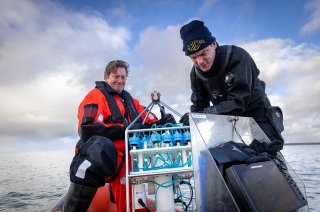
Showcase
Eyes and ears and DNA tests below the water line
Soon, the Biodiversity Sensing Box will be the eyes, ears and laboratory for researchers who want to know about the species that live under the water’s surface. This will give a better picture of biodiversity in places where diving is difficult or impossible. Researcher Reindert Nijland of Wageningen University & Research (WUR) explains why the Biodiversity Sensing Box is such an important asset to their underwater biodiversity research.
Locks and weirs may make rivers more navigable but they also have disadvantages. Hydraulic engineering structures such as these form a major obstacle for fish. Their presence – and the fish ladders and other ‘bypasses’ that are then built to allow the fish to swim further – affect the diversity of wildlife in the water. At sea, wind farms, electric cables and drilling platforms also cause changes in underwater life. The construction work can be a temporary disruption; once the structure is in place, some animals and plants will stay away while others may be attracted to the new habitat. The Biodiversity Sensing Box supports underwater biodiversity research.
The Biodiversity Sensing Box has a camera, can record sounds and can take water samples independently